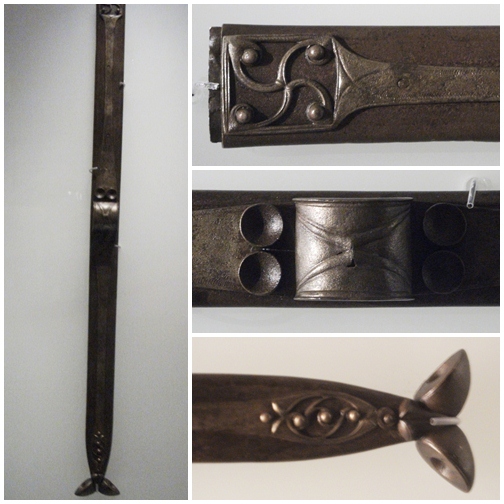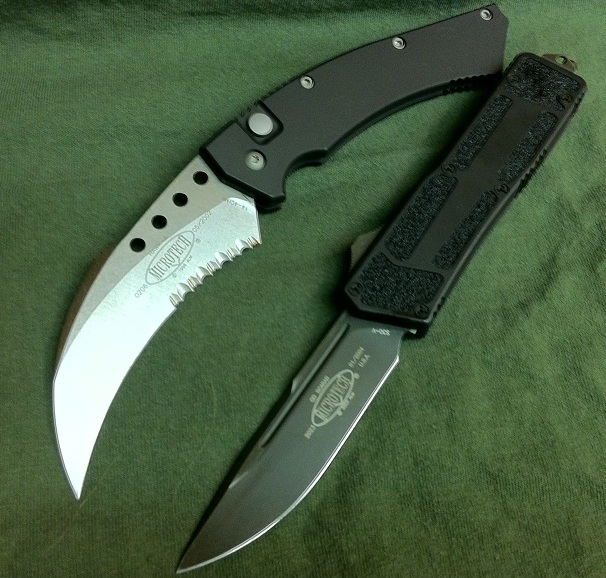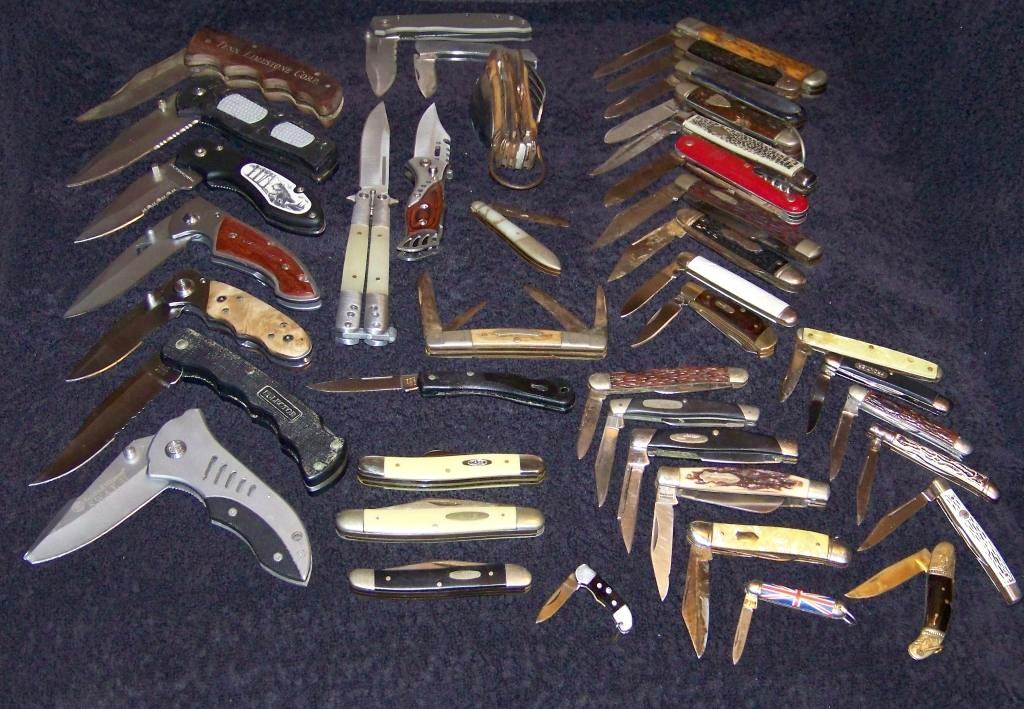|
Sheath Knife
A sheath knife is a fixed-bladed knife that fits into a sheath, by tradition usually of leather, now often of other material such as nylon or kevlar. The sheath is used to protect the knife and act as a carrier. Most importantly, the sheath protects the person carrying the knife (e.g. in the pocket or hanging on the belt) from potentially serious injuries that the sharp blade could easily cause if unprotected. To provide sufficient protection, sheaths made of soft materials, such as leather, often have reinforcements, inside or outside, made of metal sheet or other suitable strong materials. The blades vary in size, shape, and construction. In Australian law, "sheath knife" has a different definition. In this case, they are a type of non-folding, fixed-blade knife which has "a sheath which withdraws into its handle", thus giving something of the effect of an " out-the-front" flick knife. These knives, like flick knives, are classed as "prohibited weapons" in Australia. Re ... [...More Info...] [...Related Items...] OR: [Wikipedia] [Google] [Baidu] |
Knife
A knife (: knives; from Old Norse 'knife, dirk') is a tool or weapon with a cutting edge or blade, usually attached to a handle or hilt. One of the earliest tools used by humanity, knives appeared at least Stone Age, 2.5 million years ago, as evidenced by the Oldowan tools. Originally made of wood, bone, and stone (such as flint and obsidian), over the centuries, in step with improvements in both metallurgy and manufacturing, knife blades have been made from copper, bronze, iron, steel, ceramic, and titanium. Most modern knives have either fixed or folding blades; blade patterns and styles vary by maker and country of origin. Knives can serve various purposes. Hunters use a hunting knife, soldiers use the combat knife, scouts, campers, and hiking, hikers carry a pocketknife; there are kitchen knives for preparing foods (the chef's knife, the paring knife, bread knife, cleaver), table knife (butter knives and steak knives), weapons (daggers or switchblades), knives for throwing o ... [...More Info...] [...Related Items...] OR: [Wikipedia] [Google] [Baidu] |
Leather
Leather is a strong, flexible and durable material obtained from the tanning (leather), tanning, or chemical treatment, of animal skins and hides to prevent decay. The most common leathers come from cattle, sheep, goats, equine animals, buffalo, pigs and hogs, ostriches, and aquatic animals such as seals and alligators. Leather can be used to make a variety of items, including clothing, footwear, handbags, furniture, tools and sports equipment, and lasts for decades. Leather making has been practiced for more than 7,000 years and the leading producers of leather today are China and India. Critics of tanneries claim that they engage in unsustainable practices that pose health hazards to the people and the environment near them. Production processes The leather manufacturing process is divided into three fundamental subprocesses: preparatory stages, tanning, and crusting. A further subprocess, finishing, can be added into the leather process sequence, but not all leathers ... [...More Info...] [...Related Items...] OR: [Wikipedia] [Google] [Baidu] |
Nylon
Nylon is a family of synthetic polymers characterised by amide linkages, typically connecting aliphatic or Polyamide#Classification, semi-aromatic groups. Nylons are generally brownish in color and can possess a soft texture, with some varieties exhibiting a silk-like appearance. As Thermoplastic, thermoplastics, nylons can be melt-processed into fibres, Thin film, films, and diverse shapes. The properties of nylons are often modified by blending with a variety of additives. Numerous types of nylon are available. One family, designated nylon-XY, is derived from diamines and dicarboxylic acids of carbon chain lengths X and Y, respectively. An important example is nylon-6,6 (). Another family, designated nylon-Z, is derived from amino acid, aminocarboxylic acids with carbon chain length Z. An example is nylon-[6]. Nylon polymers have extensive commercial applications, including uses in textiles and fibres (such as apparel, flooring and rubber reinforcement), molded components fo ... [...More Info...] [...Related Items...] OR: [Wikipedia] [Google] [Baidu] |
Kevlar
Kevlar (para-aramid) is a strong, heat-resistant synthetic fiber, related to other aramids such as Nomex and Technora. Developed by Stephanie Kwolek at DuPont in 1965, the high-strength material was first used commercially in the early 1970s as a replacement for steel in racing tires. It is typically spun into ropes or fabric sheets that can be used as such, or as an ingredient in composite material components. Kevlar has many applications, ranging from bicycle tires and sailcloth#Kevlar, racing sails to bulletproof vests, due to its high Specific strength, tensile strength-to-weight ratio; by this measure it is five times stronger than steel. It is also used to make modern marching drumheads that withstand high impact, and for Mooring, mooring lines and other underwater applications. A similar fiber, Twaron, with the same chemical structure was developed by Akzo in the 1970s. Commercial production started in 1986, and Twaron is manufactured by Teijin Aramid. History Poly- ... [...More Info...] [...Related Items...] OR: [Wikipedia] [Google] [Baidu] |
Scabbard
A scabbard is a sheath for holding a sword, dagger, knife, or similar edged weapons. Rifles and other long guns may also be stored in scabbards by horse riders for transportation. Military cavalry and cowboys had scabbards for their saddle ring carbines and rifles for transportation and protection. Scabbards have been made of many materials over the millennia, including leather, wood, and metal such as brass or steel. Most commonly, sword scabbards were worn suspended from a sword belt or shoulder belt called a baldric. Antiquity Scabbards have at least been around since the Bronze Age, and are thought to have existed as long as the blade has. Wooden scabbards were typically covered in fabric or leather; the leather versions also usually bore metal or leather fittings for added protection and carrying ease. All-metal scabbards were popular items for a display of wealth among elites in the European Iron Age, and often intricately decorated. Little is known about the scabbards ... [...More Info...] [...Related Items...] OR: [Wikipedia] [Google] [Baidu] |
Sliding Knife
An OTF Knife, also known as an out-the-front knife, sliding knife, telescoping knife, or angel blade, is a pocketknife with a blade that opens and closes through a hole in one end of the handle. This design contrasts with the majority of utility knives, which are either standard folding knives or are "fixed blade" sheath knives (having no mechanical operation). "OTF" only refers to the basic portion of the knife's mechanical operation where the blade slides parallel with the handle to deploy. Switchblades and gravity knives provide a great variety of different OTF mechanisms. "Gentlemen's" OTF knives Illustrated above are four very small OTF knives. Figure A shows simple rocking jaw type button, and Figure B is a roll-lock design. Both figures depict gravity knives that fall open. The leading edge of the roll cap or jaw acts as a hole cover when closed, and rests in a groove milled across the open blade tang in order to lock open. Figures C and D are known as sliders or sl ... [...More Info...] [...Related Items...] OR: [Wikipedia] [Google] [Baidu] |
Switchblade
A switchblade (also known as switch knife, automatic knife, pushbutton knife, ejector knife, flick knife, gravity knife, flick blade, or spring knife) is a pocketknife with a sliding or pivoting blade contained in the handle which is extended automatically by a spring when a button, lever, or switch on the handle or bolster is activated. Virtually all switchblades incorporate a locking blade, a means of preventing the blade from being accidentally closed while in the open position. An unlocking mechanism must be activated in order to close the blade for storage. During the 1950s, US newspapers as well as the tabloid press promoted the image of a new violent crime wave caused by young male delinquents with a switchblade or flick knife, based mostly on anecdotal evidence. In 1954, Democratic Rep. James J. Delaney of New York authored the first bill submitted to the U.S. Congress banning the manufacture and sale of switchblades, beginning a wave of legal restrictions worldwid ... [...More Info...] [...Related Items...] OR: [Wikipedia] [Google] [Baidu] |
Pocket Knife
A pocketknife (also spelled as pocket knife) is a knife with one or more blades that fold into the handle. They are also known as jackknives, folding knives, EDC knife, or may be referred to as a penknife, though a penknife may also be a specific kind of pocketknife. A typical blade length is . Pocketknives are versatile tools, and may be used for anything from whittling and woodcarving, to butchering small game, gutting and filleting small fish, aiding in the preparation of tinder and kindling for fires, boring holes in soft material, to opening an envelope, cutting twine, slicing fruits and vegetables or as a means of self-defense. Pocketknives may also be used in conjunction with other tools and equipment for woodcraft and bushcraft. Specialised designs are also used for mushroom hunting and gardening. Pocketknives designed for gardening include pruning knives, which are folding knives with long curved blades used for pruning, trimming cuttings, taking buds and preparing ... [...More Info...] [...Related Items...] OR: [Wikipedia] [Google] [Baidu] |
Knives
A knife (: knives; from Old Norse 'knife, dirk') is a tool or weapon with a cutting edge or blade, usually attached to a handle or hilt. One of the earliest tools used by humanity, knives appeared at least 2.5 million years ago, as evidenced by the Oldowan tools. Originally made of wood, bone, and stone (such as flint and obsidian), over the centuries, in step with improvements in both metallurgy and manufacturing, knife blades have been made from copper, bronze, iron, steel, ceramic, and titanium. Most modern knives have either fixed or folding blades; blade patterns and styles vary by maker and country of origin. Knives can serve various purposes. Hunters use a hunting knife, soldiers use the combat knife, scouts, campers, and hikers carry a pocketknife; there are kitchen knives for preparing foods (the chef's knife, the paring knife, bread knife, cleaver), table knife ( butter knives and steak knives), weapons (daggers or switchblades), knives for throwing or juggli ... [...More Info...] [...Related Items...] OR: [Wikipedia] [Google] [Baidu] |








